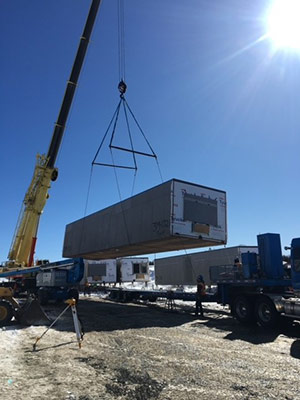Constructing change through off-site building research
Author: Tim Jaques
Posted on Aug 19, 2024
Category: UNB Saint John , Research , UNB Fredericton

Brandon Searle (D-TME'15, BScEng'16, MScEng'22) remembers the long hours family members worked during construction season.
“My grandfather was a foreman. My parents told me he was very busy. There were other members of my family in the industry too and they certainly were often away working long hours,” said Searle, the innovation director of the Off-site Construction Research Cente (OCRC) at the University of New Brunswick’s (UNB) Fredericton campus.
A different form of construction, called off-site construction, may change that by having more of the building fabricated in factories rather than at the job site itself.
Established in September 2018 with a $2-million contribution from OSCO Construction Group, OCRC is pioneering a revolutionary shift to off-site prefabrication of buildings and infrastructure that will allow people like Searle’s family members to balance work and life through regular shifts in a plant or factory.
“We are mandated to do industry-driven applied research for more efficient, safer and cost-effective construction practices,” said Searle.
Twelve of OCRC’s 14 board members are from the private sector. Its mission is “accelerating construction innovation through the improvement and adoption of off-site construction technologies and practices.”
It seeks to move the construction industry from traditional on-site construction (also called “stick-built” or “site-built” construction) to manufacturing sections or modules at a factory (called “industrialized construction”) for assembly at a job site.
Searle said demand is strong in the building sector, particularly for health-care facilities, housing, and schools, and a diminishing pool of skilled and general labour as the retirement of older workers has heightened the need for less labour-intensive construction methods.
“Research has shown that if the work is done in a factory, the quality is better, it is safer for labour and projects can be completed more quickly through a crunched schedule,” Searle said, adding that some workers who might not be able to withstand conditions at a traditional work site may do well at an off-site manufacturing facility.
OCRC used WorkSafe NB data to quantify the risks of different tasks labourers would do on a traditional stick-built job site versus what they would do in a factory and found the latter was four times safer.
“The other thing is quality. There is such a demand for housing right now that quality and energy efficiency may be taking a back seat. With buildings constructed in a factory-controlled environment, quality is increased,” he said.
Searle gave an example of a hotel in Florenceville-Bristol, N.B constructed of modules built in a Sussex, N.B. factory. These modules, complete with televisions, beds, dressers, and bathroom fixtures were transported to Florenceville-Bristol and assembled rather than constructed on-site, with only the mechanical, fire, electrical and plumbing connections done locally. This method ensured higher quality, quicker construction and safety.

Another benefit, often not discussed, is cost certainty. While we often hear of the cost of projects following the initial estimate, many construction projects experience cost overruns throughout the lifecycle of the project. In off-site construction, the cost is far less variable following the estimate.
The 203 Fitzroy Street project in Charlottetown, P.E.I. was constructed off-site in Bouctouche, N.B. Despite the variable and increasing materials costs caused by doing construction during the pandemic, the off-site portion of the project experienced only a two per cent cost overrun, compared to a 20 per cent overrun for the on-site work.
Off-site construction does come with challenges. Contractors must make significant upfront expenditures, often between 30 to 50 per cent of the project cost before seeing tangible results, which can make lenders and insurers wary.
On the manufacturing side, acquiring and maintaining an off-site factory can be expensive.
Building inspectors and local government officials may need training in off-site construction. Permitting and land acquisition remain “a bottleneck,” and the traditional supply chain, including skilled labour, must learn how to adapt.
However, with off-site construction methods, a job can be completed faster.
“You can do all your underground and civil work in parallel to doing your modules in the factory. There have been several cases where off-site methods have proven that a 24-month project can take half that time through the scheduling benefits.”
Off-site construction offers economies of scale, customization capabilities and reduced waste. OCRC members visited an off-site construction factory in Belgium where burning the leftover wood heated the building.
Additionally, off-site construction allows manufacturers to purchase materials when prices are more competitive, further driving down costs.
The New Brunswick Housing Corporation is already working with modular home manufacturers and OCRC plans to conduct a case study comparing traditional and modular approaches. OCRC also participates in the development of standards and procurement strategies through committees with the Canadian Standards Association Modular Building Institute among others.
OCRC’s efforts extend beyond New Brunswick. It is leading a project with the National Research Council to decarbonize the construction sector at scale, partnering with other universities to assess and benchmark industry practices. Additionally, OCRC is collaborating with a company based in Nunavut to help build more affordable and energy-efficient homes in the North.
OCRC successfully pitched the development of a new advanced methods of construction program to New Brunswick’s Department of Post-Secondary Education, Training and Labour and hopes to have the first cohort start in September 2025.
“It is meant to be a certificate and diploma program and is targeted towards both senior-year students and existing workers in the construction industry,” Searle said.
“The program will focus on marrying construction engineering and management with industrial engineering thinking with a focus on lean production, design for manufacturing and assembly, automation and robotics, as well as Building Information Modelling, digital technologies and building science.”
OCRC involves students in its projects, providing internships and co-op opportunities, including five co-op students hired this summer.
Many are graduate students in computer science or civil or mechanical engineering. They do internships with partner companies.
“Every two weeks, we have a lunch-and-learn, and they can present some of the projects they are working on, seek feedback from our staff and their peers, and share knowledge within the team.
An example is Ocean Steel & Construction Ltd. in Saint John, an OSCO Construction Group division.
“We’ve had students there since 2019 doing time studies to help them increase the productivity in their factory or help pilot and implement new technologies,” Searle said.
“We have also worked with the Master of Technology Management and Entrepreneurship program and brought some problems we hear from our industry partners to students starting their MTME degrees. We tell them about a problem our industry partners are facing and ask them to help solve it.”
OCRC also pitches ideas or problems on behalf of industry partners for the capstone design projects senior UNB engineering and forestry and environmental management students do each year. These group projects involve an idea or challenge related to their specific area of study.
“The students develop a prototype to solve that problem and present it to the companies at the end of the semester.”
OCRC is hosting an international conference at UNB on off-site construction called Transforming Construction with Off-site Methods and Technologies from Aug. 20 to 22. The conference will bring together experts from academia, industry and the public sector.
Held in partnership with Northumbria University in Newcastle, U.K., the conference features workshops, research presentations, and industry case studies, fostering collaboration and innovation. This is the second international conference OCRC has hosted.
“It is meant to bring academia and industry together to exchange knowledge and bridge the gap between industry, academia and the public sector,” said Searle.
Through these initiatives, OCRC is paving the way for a more efficient, sustainable, and innovative construction industry through off-site construction.
“We ultimately do research and case studies to make buildings and infrastructure safer, quicker, and more efficient to build and maintain, with hopes of training people who will bring real innovation and make a positive difference in the Canadian construction sector,” said Searle.
Photo: Zhen Lei, Jeff Rankin and Brandon Searle of the Off-site Construction Reseach Centre (OCRC) at the University of New Brunswick’s (UNB) Fredericton campus.
